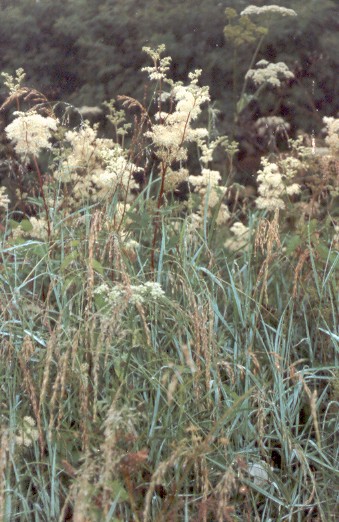
Filipendula ulmaria (L)
Synonyms and Common names: Spiraea ulmaria (L.), Bridewort, meadow queen, meadow-wort, pride of the meadow, queen of the meadow, lady of the meadow, dollof, meadsweet
French = Ulmaire, Spanish and Italian = Ulmaria
Order: Rosaceae

Description: Meadowsweet is a perennial herb, growing in damp meadows, ditches and bogs, at the edges of ponds, on river banks and in damp open woodland. Common throughot Europe, it is also be found in the eastern US and Canada as far west as Ohio. The creeping rootstock sends up a reddish, angular stem, up to 120cm tall, branched near the top and bearing alternate long-petioled leaves composed of two to five pairs of ovate, serrate leaflets which are widely tomentose beneath. The small, creamy-white five-petaled flowers with over twenty protruding stamens grow in panicled cymes from June to August.
Parts used: aerial parts
Collection: The flowers are gathered during the flowering period from and should be dried gently.
Constituents: Volatile oil containing salicylaldehyde, phenolic glycosides (including spiraein, monotropin and gaultherin), mucilage, flavonoids, tannins, vitamin C, sugar
Actions: stomachic, mild urinary antiseptic, antirheumatic, astringent, antacid, anti-inflammatory, diuretic, diaphoretic, antiemetic, tonic
Indications: peptic ulcer (prophylaxis and treatment), atonic dyspepsia with heartburn and hyperacidity, gastritis, peptic ulceration, acute catarrhal cystitis.
Therapeutics and Pharmacology: Filipendula is an excellent digestive remedy. It protects and soothes the mucous membranes of the digestive tract, reducing excess acidity and alleviating nausea, and can be used in the treatment of heartburn, hyperacidity, gastritis and peptic ulceration. The anti-inflammatory action of the salicylates in Filipendula makes it effective against rheumatic pain while the tannins and mucilages appear to buffer the adverse effects of isolated salicylates which can cause gastric bleeding (Aspirin can cause gastric ulceration). Phenolic glycosides such as monotropitin yield salicylic aglycones which contribute to the anti-inflammatory and diuretic actions. The astringent tannins make Filipendula a useful remedy in the treatment of diarrhoea in children.
In Germany, Filipendula is used as a supportive treatment for common colds. Here, the salicylic acid acts to reduce fever. It is also recommended for water retention and for bladder and kidney ailments. Externally the infusion can serve as a wash for wounds or inflamed eyes.
Combinations: Filipendula combines well with Althaea and Melissa in treatment of gastric conditions and with Ballota in vomiting.
Caution: Filipendula should be avoided by those with a hypersensitivity to salicylates. If the tincture is to be used to treat gastric ulceration or excess acidity, the alcohol content, which might otherwise irritate the gut, can be reduced by adding it to boiling water.
Preparation and Dosage: (thrice daily)
Regulatory Status: GSL Schedule 1
2-6g or by infusion
Liquid extract: 1:1 in 25% alcohol, 2-6ml
Tincture: 1:5 in 25% alcohol, 2-4ml
Additional Comments: Meadowsweet was one of the three herbs held most sacred to the Druids (Vervain and Water-mint being the other two). It was one of the fifty ingredients in a drink called 'Save' in Chaucer's 'Knight's Tale', where it was called Medwort or Meadwort. It was also a popular Elizabethan strewing herb. The name Ulmaria is given in allusion to the resemblance of its leaves to those of the elm (Ulmus). In 1838 the Italian Rafaele Piria first produced salicylic acid from the flowerbuds of meadowsweet and from willow bark (Salix alba). In 1899 the drug company Bayer formulated a new drug (acetylsalicylic acid) and called it aspirin, a name which is derived from the old botanical name for meadowsweet, Spiraea ulmaria.
Bibliography
Bartram, T. 1995 Encyclopaedia of Herbal Medicine, 1st edn., Grace Publishers, Bournemouth.
Bradley, P.R. (ed.) 1992 British Herbal Compendium, Volume 1, BHMA, Bournemouth.
Bremness, L. 1994 Herbs, Dorling Kindersley Eyewitness Handbook, London.
BHMA 1983 British Herbal Pharmacopoeia, BHMA, Bournemouth.
Chevallier, A. 1996 The Encyclopaedia of Medicinal Plants, Dorling Kindersley, London.
Grieve, M. 1931 A Modern Herbal, (ed. C.F. Leyel 1985), London.
Hoffmann, D. 1990 The New Holistic Herbal, Second Edition, Element, Shaftesbury.
Hyperhealth 1996 Natural Health and Nutrition Databank, v.96.1 CD-ROM, �In-Tele-Health, available from Healthworks, Leeds. ISBN 0-646-30942-0
Lust, J. 1990 The Herb Book, Bantam, London.
Mabey, R. (ed.) 1991 The Complete New Herbal, Penguin, London.
Mills, S.Y. 1993 The A-Z of Modern Herbalism, Diamond Books, London.
Newall, C.A., Anderson, L.A., & Phillipson, J.D. 1996 Herbal Medicines: A Guide for Health-care Professionals, The Pharmaceutical Press, London.
Ody, P. 1993 The Herb Society's Complete Medicinal Herbal, Dorling Kindersley, London.
Polunin, M. and Robbins, C. 1992 The Natural Pharmacy, Dorling Kindersley, London.
Prihoda, A. 1989 The Healing Powers of Nature, Octopus, London.
Weiss, R.F. 1991 Herbal Medicine, Beaconsfield Arcanum, Beaconsfield.
Wren, R.C. 1988 Potter's New Cyclopaedia of Botanical Drugs and Preparations, C.W.Daniel, Saffron Walden.










